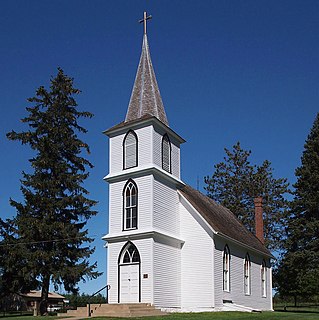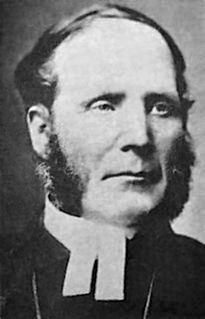
The Evangelical Covenant Church (ECC) is a Radical Pietistic denomination in the evangelical Christian tradition. The denomination has more than 875 congregations and an average worship attendance of 280,000 people in the United States and Canada with ministries on five continents. Founded in 1885 by Swedish immigrants, the church is now one of the most rapidly growing and multi-ethnic denominations in North America. Historically Lutheran in theology and background, it is now a broadly evangelical movement.

The American Lutheran Church was a Christian Protestant denomination in the United States and Canada that existed from 1960 to 1987. Its headquarters were in Minneapolis, Minnesota. Upon its formation in 1960, the ALC designated Augsburg Publishing House, also located in Minneapolis, as the church publisher. The Lutheran Standard was the official magazine of the ALC.

Eric Norelius was a Swedish-American Lutheran minister, church leader, and author.

Augustana Academy was an educational institution in Canton, South Dakota.
The Augustana Evangelical Lutheran Church was a Lutheran church body in the United States that was one of the churches that merged into the Lutheran Church in America (LCA) in 1962. It had its roots among the Swedish immigrants in the 19th century.
The Evangelical Lutheran Church (ELC) was a Lutheran denomination that existed from 1917, when it was founded as the Norwegian Lutheran Church of America (NLCA), until 1960, when it joined two other church bodies to form the second American Lutheran Church.

The United Norwegian Lutheran Church of America (UNLC) was the result of the union in 1890 of the Norwegian Augustana Synod, the Conference of the Norwegian-Danish Evangelical Lutheran Church of America (1870), and the Anti-Missourian Brotherhood (1887). Some sources give the church's name as "in America" instead of "of America",

Lars Paul Esbjörn was a Swedish-American Lutheran clergyman, academic and church leader. Esbjörn was a founder of the Augustana Evangelical Lutheran Church and of Augustana College. He served as the first president of Augustana College from 1860 until his resignation in 1863.

The Norwegian Lutheran Church in the United States is a general term to describe the Lutheran church tradition developed within the United States by immigrants from Norway.

Christdala Evangelical Swedish Lutheran Church is a historic church located in Forest Township, Rice County, Minnesota. It is situated 11 miles (18 km) west of Northfield at 4695 Millersburg Blvd.

Erland Carlsson was a Swedish-American Lutheran Minister. He was one of the founders and served as President of the Augustana Lutheran Synod.

Nils Gustaf Nicolaus Bergensköld (1838–1907) was a Swedish-American Lutheran clergyman and an early leader of the revivalist movement within Swedish immigrant settlements of the Midwestern United States during the later part of the 19th century.

Old Main, Augustana College is an historic building located in Rock Island, Illinois, United States. It was built between 1884 and 1893 on the campus of Augustana College, and it was listed on the National Register of Historic Places in 1975.

Kansas Lake Evangelical Lutheran Church was a small, rural church located near Butterfield, Minnesota. Formed in 1871 by Swedish-Americans settling in the area, the church served the local population for 138 years before closing in 2009.

Augustana Lutheran Church is an Evangelical Lutheran Church in America congregation located in Sioux City, Iowa, United States. The church building was listed on the National Register of Historic Places in 2006 as Swedish Evangelical Lutheran Augustana Church.

Immanuel Evangelical Lutheran Church is a Lutheran church located in Boise, Idaho. The church was individually listed on the National Register of Historic Places on June 17, 1976.<ref="nris"/> It was included as a contributing property in the Fort Street Historic District on November 12, 1982.

The Swedish Evangelical Lutheran Church is a historic church building in Millville, Minnesota, United States. It was built in 1874 and used successively by Swedish, Norwegian, and German immigrant congregations. The church and its adjacent cemetery were listed on the National Register of Historic Places in 1989 for having local significance in the theme of European ethnic heritage. It was nominated for being the only intact surviving ethnic church from the peak of European immigration to Wabasha County.
Peter Carlson was a Swedish-American Lutheran Minister who helped found the Augustana Evangelical Lutheran Synod and served as president of the Minnesota Conference for six years.

New Sweden Chapel is a historic Lutheran Church building located east of Fairfield, Iowa, United States in rural Jefferson County. The Swedish immigrant community that settled here was organized in 1845 under the leadership of Peter Cassel, a native of Kisa, Östergötland, Sweden. This was the first Swedish settlement in Iowa, as well as the first west of the Mississippi River. They established a Lutheran congregation in 1848, and built a log church in 1851. This church replaced it in 1860. Local builder Henri Jagle was responsible for building the 50-by-30-foot frame structure. It is four bays in length and features a 16-foot (4.9 m) tower with a spire over the main entrance. The interior features a painting by Olaf Grafström, who was an art instructor at Augustana College in Rock Island, Illinois. In 1948 the Augustana Evangelical Lutheran Church named the New Sweden Chapel as a National Synodial Shrine in recognition of its being the oldest of congregation in the synod. Prince Bertil of Sweden and the Archbishop of Uppsala participated in a ceremony that drew 3,000 people. The chapel no longer houses a regular congregation, but is used for special occasions. A cemetery is located on the church grounds. The chapel was listed on the National Register of Historic Places in 1977.

Augustana Lutheran Church is a church in downtown Minneapolis, Minnesota, built in the Gothic Revival style. Architect William H. Dennis built the church in 1883. The church building, located 704 11th Ave. S., was home to many Scandinavian parishioners in the early decades of existence. The church initially served a large immigrant population in the city of Minneapolis, and the congregation often heard from pastors who traveled from Sweden and Norway. However, as the downtown population changed, the church congregants also shifted. By the 1960s, many Lutherans attended newer churches in suburban Twin Cities neighborhoods. By 2014, the church had less than 100 members, who sold the building.



















